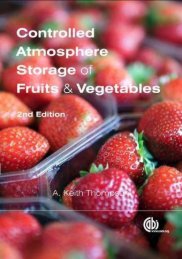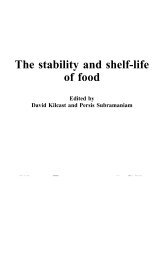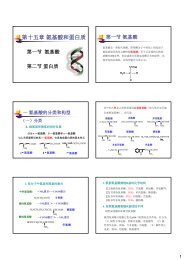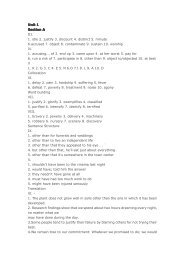Effectiveness of modified atmosphere packaging in preserving a ...
Effectiveness of modified atmosphere packaging in preserving a ...
Effectiveness of modified atmosphere packaging in preserving a ...
Create successful ePaper yourself
Turn your PDF publications into a flip-book with our unique Google optimized e-Paper software.
Packag<strong>in</strong>g Technologyand Scienceis grow<strong>in</strong>g as a result <strong>of</strong> lifestyle changes and consumers’<strong>in</strong>creased demand for convenience foods.To ma<strong>in</strong>ta<strong>in</strong> their high quality, they are usuallydistributed under chilled conditions. Extend<strong>in</strong>gour understand<strong>in</strong>g <strong>of</strong> the effects <strong>of</strong> MAP on storagestability should be helpful <strong>in</strong> design<strong>in</strong>g storageconditions and extend<strong>in</strong>g the shelf lives <strong>of</strong> thiscategory <strong>of</strong> foods.MATERIALS AND METHODSPreparation <strong>of</strong> braised green pepperswith dry anchoviesAs a typical comb<strong>in</strong>ation ready-to-eat product,braised green peppers with dry anchovies wereselected for this study based on its central position<strong>in</strong> Korean side dish products. 6 The braised greenpeppers with dry anchovies were processed follow<strong>in</strong>gthe typical traditional preparation procedure.First, 25 g <strong>of</strong> soy sauce, 30 g <strong>of</strong> sugar and175 ml <strong>of</strong> tap water were comb<strong>in</strong>ed <strong>in</strong> a previouslyheated kettle, and were heated with mix<strong>in</strong>g for30 s. Corn syrup (50 ml) was added to the mixture,which was heated for another 30 s. Dry anchovies(150 g) that had been heated <strong>in</strong> a fry<strong>in</strong>g pan for1 m<strong>in</strong> were added to the braised mixture, and then200 g <strong>of</strong> green peppers from which the pedicleparts had been removed was added. The wholemixture was braised with cont<strong>in</strong>uous mix<strong>in</strong>g for4 m<strong>in</strong> and cooled under ambient conditions, produc<strong>in</strong>gabout 500 g <strong>of</strong> f<strong>in</strong>al product. Large quantities<strong>of</strong> this formulation <strong>in</strong> 22 batches were prepared,mixed thoroughly for homogeneity, and then usedfor the storage test.Packag<strong>in</strong>g and storage <strong>of</strong> the productTo evaluate the primary quality <strong>in</strong>dex, the preparedproduct was divided <strong>in</strong>to 80 g portions,placed on a polystyrene tray (18 × 13 × 2.5 cm), andstretch-wrapped <strong>in</strong> air with 12 mm thick l<strong>in</strong>ear lowdensitypolyethylene (LLDPE) film (Clean Wrap,Busan, Korea), which had an oxygen permeance <strong>of</strong>616 ml/h/m 2 /atm at 10°C. The product was storedat 10°C for 14 days, and a headspace gas compositionclose to atmospheric air was ma<strong>in</strong>ta<strong>in</strong>ed. In thestorage test under gas-flushed conditions, theK-E. LEE ET AL.products (80 g portions) were placed on a polypropylenetray (11 × 7.3 × 3.5 cm) and were packagedwith a multilayered 12 mm nylon/polyethylene/nylon/ethylene v<strong>in</strong>yl alcohol (EVOH)/nylon/polyethylene/LLDPE gas barrier film (18 × 13 cm)(T6035B, oxygen permeance less than 5 ml/day/m 2 /atm at 23°C accord<strong>in</strong>g to the manufacturer’s<strong>in</strong>formation, Sealed Air, Duncan, SC, USA). Thef<strong>in</strong>al free volume was equal to 150 ml. The follow<strong>in</strong>g<strong>modified</strong> <strong>atmosphere</strong>s supplied from premixedcyl<strong>in</strong>ders were tested: 30% CO 2 /70% N 2 ,60% CO 2 /40% N 2 , and 100% CO 2 . In the storagetest <strong>of</strong> MAP, air-filled control and vacuum packageswere also prepared for comparative purposes.All packaged products were stored at constanttemperatures (5, 10, 15 or 20°C), and quality assessmentswere conducted periodically. Most <strong>of</strong> thestorage tests were carried out at 10°C, which is theusual temperature limit proposed for stor<strong>in</strong>gchilled foods to ensure their safety. 7–9 Storage testsat higher temperatures also simulated abusivestorage conditions to exam<strong>in</strong>e the effects <strong>of</strong> temperatureas an impediment to preservation.Quality analysesTriplicate samples <strong>of</strong> each treatment were used toassess the quality attributes <strong>of</strong> the stored products.Aerobic bacterial and yeast/mould growth,expressed <strong>in</strong> colony-form<strong>in</strong>g units (CFU) per gram,were quantified as the major <strong>in</strong>dices <strong>of</strong> microbialquality. Samples (25 g) <strong>of</strong> the green peppers or dryanchovies were aseptically transferred <strong>in</strong>to sterilestomacher bags, to which 75 ml <strong>of</strong> sterile 0.5%peptone water was then added. 10 The sampleswere then homogenized <strong>in</strong> a stomacher (Lab-Blender, TMC International, Seoul, Korea) for4 m<strong>in</strong>. Aliquots <strong>of</strong> 1 ml were plated directly or as10-fold dilutions <strong>in</strong> 0.5% peptone water onto platecount agar (PCA, Difco Laboratories, Detroit, MI,USA) for total aerobic bacterial counts, or onto pHadjusted(to pH 3.5 with 10% tartaric acid) potatodextrose agar (PDA, Difco Laboratories) for yeast/mould counts. The colonies on the PCA plates<strong>in</strong>cubated for 72 h at 30°C were counted as totalaerobic bacterial counts, and were expressed <strong>in</strong>CFU per gram. The PDA plates were <strong>in</strong>cubated for5 days at 25°C, after which the yeast/mould countswere recorded.Copyright © 2008 John Wiley & Sons, Ltd. 418 Packag. Technol. Sci. 2008; 21: 417–423DOI: 10.1002/pts
Packag<strong>in</strong>g Technologyand Sciencecific growth rate (1/day), N max = maximum celldensity <strong>in</strong> CFU/g, and A is def<strong>in</strong>ed as( )−µ maxttlagµmax1 ⎛ e + 1 e −1⎞A= t+ ⋅ln⎜t µµ ⎝ 1+ 1 ( e −1⎟ , with tlag maxmax)lag =⎠lag time.The microbial growth k<strong>in</strong>etic parameters (logN o ,logN max , m max and t lag ), determ<strong>in</strong>ed us<strong>in</strong>g theMicroFit programme (Institute <strong>of</strong> Food Research,Norwich, UK), can be used to analyse the effects<strong>of</strong> storage or <strong>packag<strong>in</strong>g</strong> variables on the microbialstability <strong>of</strong> the food. 16–18log(CFU/g)98765432100 5 10 15 20 25 30Time (day)Figure 2. Effect <strong>of</strong> different MAPs on the growth <strong>of</strong>aerobic bacteria on the green peppers <strong>of</strong> the braised sidedish product stored at 10°C. , Air control; , vacuum;, 30% CO 2 and 70% N 2 ; , 60% CO 2 and 40% N 2 ;and , 100% CO 2 . The solid l<strong>in</strong>es are fi tted to Equation1, except for the condition <strong>of</strong> 100% CO 2 .MAP versus air <strong>packag<strong>in</strong>g</strong>K-E. LEE ET AL.The effects <strong>of</strong> MAP on the quality <strong>of</strong> the productwere also <strong>in</strong>vestigated, and the ma<strong>in</strong> results <strong>of</strong> thestorage at 10°C are presented. MAP with ≥30%CO 2 significantly retarded bacterial growth onthe product (Figure 2). Packag<strong>in</strong>g with 100% CO 2resulted <strong>in</strong> negligible growth <strong>of</strong> aerobic bacteriaafter 36 days <strong>of</strong> storage at 10°C. Compared withair <strong>packag<strong>in</strong>g</strong>, vacuum <strong>packag<strong>in</strong>g</strong> gave a slightlyextended lag time (Table 1). The effect <strong>of</strong> 30% CO 2and 70% N 2 was ma<strong>in</strong>ly conf<strong>in</strong>ed to a lowermaximum specific growth rate, whereas 60% CO 2and 40% N 2 produced both an extended lag timeand a reduced growth rate. The effectiveness <strong>of</strong>CO 2 <strong>in</strong> <strong>in</strong>hibit<strong>in</strong>g microbial growth is well known,and high CO 2 concentrations are widely used <strong>in</strong>MAP to ma<strong>in</strong>ta<strong>in</strong> the quality and extend the shelflife <strong>of</strong> meat, fish, dairy and fresh pasta products,which are susceptible to bacterial spoilage. 1,19,20Although MAP conditions <strong>of</strong> 100% CO 2 best<strong>in</strong>hibited bacterial growth on the product, theseconditions are <strong>of</strong>ten avoided <strong>in</strong> the <strong>packag<strong>in</strong>g</strong> <strong>of</strong>chilled prepared foods because <strong>of</strong> package collapseand tissue discolouration by the dissolution <strong>of</strong> CO 2<strong>in</strong>to aqueous and fatty foods. The product used <strong>in</strong>this study, braised green peppers with dry anchovies,also underwent a slight visible discolourationdur<strong>in</strong>g <strong>packag<strong>in</strong>g</strong> with 100% CO 2 , which caused asensory colour score slightly below that <strong>of</strong> theother <strong>packag<strong>in</strong>g</strong> processes (hedonic colour scores,without statistical significance <strong>in</strong> difference at a =0.05, for the green peppers <strong>of</strong> 7.7 with air, 7.9 witha vacuum, 8.4 with 30% CO 2 /70% N 2 , 9.5 with 60%Table 1. Microbial growth parameters for the prepared foodproduct under different <strong>packag<strong>in</strong>g</strong> conditionsMicrobial growth parameters(Equation 1)Packag<strong>in</strong>gN o N max m max t lagR 2Air control 1.35 8.09 2.23 3.55 0.980Vacuum 1.27 6.92 2.10 4.01 0.97230% CO 2 /70% N 2 1.34 6.33 0.66 3.82 0.99360% CO 2 /40% N 2 1.58 6.08 0.80 5.70 0.986Copyright © 2008 John Wiley & Sons, Ltd. 420 Packag. Technol. Sci. 2008; 21: 417–423DOI: 10.1002/pts
EFFECTIVENESS OF MAP FOR A PREPARED FOODCO 2 /40% N 2 , and 7.4 with 100% CO 2 ). Consider<strong>in</strong>gall these factors, we used MAP with 60% CO 2 /40%N 2 <strong>in</strong> the subsequent studies to exam<strong>in</strong>e the temperatureeffect on MAP and air <strong>packag<strong>in</strong>g</strong>. Thisgas composition is the most commonly used <strong>atmosphere</strong>for the MAP <strong>of</strong> fish, fresh pasta, pre-cookedmeat and comb<strong>in</strong>ation products to <strong>in</strong>hibit microbialspoilage and oxidative deterioration. 1,2,4,5,12The effect <strong>of</strong> storage temperature on microbiologicalevolution is given <strong>in</strong> Figure 3 for stretchwrapair <strong>packag<strong>in</strong>g</strong> and MAP with 60% CO 2 /40%N 2 . It was confirmed that this high CO 2 MAPextends the lag time and reduces the growth rate<strong>of</strong> aerobic bacteria. MAP did not allow an <strong>in</strong>crease<strong>in</strong> the aerobic bacterial count for 58 days at 5°C.The temperature effect on microbial spoilagewas analysed by <strong>in</strong>vestigat<strong>in</strong>g the parameters <strong>of</strong>the aerobic bacterial growth curves (Equation 1) atdifferent temperatures. The <strong>in</strong>crease <strong>in</strong> the lag timeand the decrease <strong>in</strong> the growth rate with decreasedtemperature could be described accord<strong>in</strong>g to alog(CFU/g)108642015 o C10 o C5 o CStretch-wrapped air <strong>packag<strong>in</strong>g</strong>0 10 20 30 40 50 60Time (day)Packag<strong>in</strong>g Technologyand Sciencesquare root model, <strong>in</strong> Equations 2 and 3, respectively(Figure 4):{ }1 t = b ⋅ T −Tlag lag lag, m<strong>in</strong> (2){ }µ max = µ ⋅ − µ m<strong>in</strong>b T T , (3)where T is temperature (°C), b lag and b m are theslope parameters, and T lag,m<strong>in</strong> and T m,m<strong>in</strong> are thehypothetical m<strong>in</strong>imum temperatures correspond<strong>in</strong>gto the extrapolation onto the x-axis <strong>of</strong> nogrowth. 21 Because lag time (t lag ) <strong>in</strong> Equation 2becomes <strong>in</strong>f<strong>in</strong>ite at T lag,m<strong>in</strong> , and maximum specificgrowth rate (m max ) <strong>in</strong> Equation 3 is zero at T m,m<strong>in</strong> ,bacterial growth is not allowed below any <strong>of</strong> thehypothetical m<strong>in</strong>imum temperatures (T lag,m<strong>in</strong> orT m,m<strong>in</strong> ).MAP with 60% CO 2 and 40% N 2 ma<strong>in</strong>ly acts to<strong>in</strong>crease the hypothetical m<strong>in</strong>imum temperatures(T lag,m<strong>in</strong> and T m,m<strong>in</strong> ) <strong>in</strong> the temperature dependence<strong>of</strong> the lag time and growth rate, rather than <strong>in</strong>fluenc<strong>in</strong>gthe slope parameters (b lag and b m ) <strong>in</strong> Equations2 and 3 (Table 2).Shelf life extension by MAPEquations 2 and 3 can be used to estimate the evolution<strong>of</strong> bacterial spoilage and the shelf life <strong>of</strong> thebraised ready-to-eat product under different temperatureconditions. Generally, an aerobic bacterialcount <strong>of</strong> 10 5 –10 7 CFU/g is used as the critical10820 o C10 o CMAP with 60% CO 2 and 40%1.81.5µ max2.52.0log (CFU/g)64215 o C5 o Ct lag -1/21.20.90.60.3t lag1.51.00.5m max 1/200 10 20 30 40 50 60Time (day)Figure 3. Growth <strong>of</strong> aerobic bacteria on the greenpeppers <strong>of</strong> the braised side dish product at differentstorage temperatures for stretch-wrap air <strong>packag<strong>in</strong>g</strong> andMAP at 60% CO 2 and 40% N 2 . The solid l<strong>in</strong>es are fi ttedto Equation 1, except for MAP at 5°C.00.00 5 10 15 20 25Temperature ( o C)Figure 4. Temperature dependence <strong>of</strong> lag time andmaximum specifi c growth rate. , t lag for stretch-wrap air<strong>packag<strong>in</strong>g</strong>; , t lag for MAP with 60% CO 2 /40% N 2 ; ,m max for stretch-wrap air <strong>packag<strong>in</strong>g</strong>; and , m max for MAPwith 60% CO 2 /40% N 2 .Copyright © 2008 John Wiley & Sons, Ltd. 421 Packag. Technol. Sci. 2008; 21: 417–423DOI: 10.1002/pts
Packag<strong>in</strong>g Technologyand ScienceK-E. LEE ET AL.Table 2. Square root model parameters used to describe the temperature dependence <strong>of</strong>aerobic bacterial growth on the green peppers <strong>in</strong> braised green peppers with dry anchoviesParameters <strong>in</strong>Equation 2 Equation 3Packag<strong>in</strong>gb lag T lag,m<strong>in</strong> R 2 b m T m,m<strong>in</strong> R 2Stretch-wrap air <strong>packag<strong>in</strong>g</strong> 0.0429 −0.10 0.993 0.0592 −20.54 0.807MAP (60% CO 2 and 40% N 2 ) 0.0486 4.24 0.998 0.0446 −17.11 0.865limit for microbial food quality. 12,22,23 In this study,a strict condition <strong>of</strong> 10 5 CFU/g was used to estimatethe conservative shelf life <strong>of</strong> the product. Asan estimate <strong>of</strong> shelf life (t s ), the time for the bacterialcount to <strong>in</strong>crease from an <strong>in</strong>itial microbialcount <strong>of</strong> 10 1.4 CFU/g (N o ) to the critical limit <strong>of</strong>10 5 CFU/g (N c ) was calculated accord<strong>in</strong>g to1 ⎛ Ncts= tlag+⎝⎜ ⎞lnµ No⎠⎟(4)maxIn Equation 4, the shelf life consists <strong>of</strong> the lagtime (t lag ) and the exponential growth phase period1 ⎛( ln N c ⎞µ max⎝⎜No⎠⎟ ), which assumes implicitly that thequality limit is met <strong>in</strong> the exponential phase: thelag time was calculated by substitut<strong>in</strong>g b lag andT lag,m<strong>in</strong> values <strong>of</strong> Table 2 <strong>in</strong>to Equation 2, and theexponential growth phase period was obta<strong>in</strong>ed byadopt<strong>in</strong>g m max given by <strong>in</strong>putt<strong>in</strong>g b m and T m,m<strong>in</strong>values <strong>of</strong> Table 2 <strong>in</strong>to Equation 3. Some typicalshelf life estimates at different temperatures were24.5 days at 5°C, 7.9 days at 10°C, and 4.3 days at15°C for stretch-wrap air <strong>packag<strong>in</strong>g</strong>; and 18.4 daysat 10°C and 7.7 days at 15°C for MAP with 60%CO 2 and 40% N 2 . The shelf life was extended 2.3times by MAP relative to that achieved with air<strong>packag<strong>in</strong>g</strong> at 10°C, and was a little less at the highertemperature <strong>of</strong> 15°C. Because there was no growthat 5°C after 58 days (Figure 3), the shelf life extensionat that low temperature was greater, suggest<strong>in</strong>gthe greater effectiveness <strong>of</strong> MAP <strong>in</strong> extend<strong>in</strong>gshelf life at lower temperatures. The greater preservativeeffect <strong>of</strong> high CO 2 at lower temperatureshas also been reported by Corbo et al. for chillstoredfish fillets. 23 Thus, chilled temperatureand MAP are commonly comb<strong>in</strong>ed for betterpreservation <strong>of</strong> perishable foods. 4,5This study exam<strong>in</strong>ed the extension <strong>of</strong> shelf lifeby MAP based on the growth <strong>of</strong> aerobic bacteria,which was used as the primary quality <strong>in</strong>dex forstretch-wrap air <strong>packag<strong>in</strong>g</strong>. MAP may change thepattern <strong>of</strong> food spoilage, and thus other spoilageorganisms, such as anaerobic microorganisms,may outcompete the aerobic bacteria, thus chang<strong>in</strong>gthe primary quality <strong>in</strong>dex used to determ<strong>in</strong>eshelf life. A further extensive study <strong>of</strong> the relationshipbetween the <strong>packag<strong>in</strong>g</strong> <strong>atmosphere</strong> and thedom<strong>in</strong>ant spoilage organisms is required to ensurethe accuracy <strong>of</strong> shelf life determ<strong>in</strong>ations underMAP conditions. In particular, the storage and distribution<strong>of</strong> MAP products at abusive temperaturesare usually not recommended and should beexam<strong>in</strong>ed carefully with respect to food safety ifapplied <strong>in</strong> practice. The heat<strong>in</strong>g step <strong>in</strong> food preparationand its relatively low water activity, around0.90, would prevent the proliferation <strong>of</strong> manypathogenic and spoilage organisms <strong>in</strong> chilledstorage. 1 Hygienic control <strong>of</strong> the process<strong>in</strong>g conditionsis still emphasized to ensure the safety andquality <strong>of</strong> the product. The results <strong>of</strong> this study arelimited by the assumption that the shelf lives <strong>of</strong>chilled foods are predom<strong>in</strong>antly determ<strong>in</strong>ed bythe total aerobic bacterial growth. 11,12,23CONCLUSIONThe effectiveness <strong>of</strong> MAP with a 60% CO 2 /40% N 2gas mixture <strong>in</strong> extend<strong>in</strong>g the shelf life <strong>of</strong> a preparedready-to-eat side dish was higher at lowerCopyright © 2008 John Wiley & Sons, Ltd. 422 Packag. Technol. Sci. 2008; 21: 417–423DOI: 10.1002/pts
EFFECTIVENESS OF MAP FOR A PREPARED FOODtemperatures. The mathematical modell<strong>in</strong>g analysis<strong>of</strong> the MAP effect on microbial growth retardationshowed that the MAP conditions <strong>of</strong> 60%CO 2 /40% N 2 raised the hypothetical m<strong>in</strong>imumtemperature <strong>in</strong> the description <strong>of</strong> the temperaturedependence <strong>of</strong> lag time and growth rate.ACKNOWLEDGEMENTThis work was supported by a research grant from theM<strong>in</strong>istry <strong>of</strong> Agriculture and Forestry, Korea.REFERENCES1. Farber JM. Microbiological aspects <strong>of</strong> <strong>modified</strong><strong>atmosphere</strong><strong>packag<strong>in</strong>g</strong> technology – a review. J.Food Prot. 1991; 54: 58–70.2. Day BPF. Guidel<strong>in</strong>es for the Good Manufactur<strong>in</strong>g andHandl<strong>in</strong>g <strong>of</strong> Modified Atmosphere Packed Food Products.The Campden Food and Dr<strong>in</strong>k Research Association:Chipp<strong>in</strong>g Campden, UK, 1992; 26–70.3. Sanguandeekul R, Siripatrawan U, Narakaew V.Changes <strong>in</strong> the quality <strong>of</strong> abalone (Haliotis as<strong>in</strong><strong>in</strong>aL<strong>in</strong>naeus) packaged under atmospheric air, vacuumand <strong>modified</strong> <strong>atmosphere</strong>. Packag. Technol. Sci. 2008;21: 159–164.4. Goulas AE. Comb<strong>in</strong>ed effect <strong>of</strong> chill storage and<strong>modified</strong> <strong>atmosphere</strong> <strong>packag<strong>in</strong>g</strong> on mussels (Mytilusgalloprov<strong>in</strong>cialis) preservation. Packag. Technol. Sci.2008; DOI: 10.1002/pts.791.5. Rosnes JT, Kleiberg GH, Sivertsvik M, Lunestad BT,Lorentzen G. Effect <strong>of</strong> <strong>modified</strong> <strong>atmosphere</strong> <strong>packag<strong>in</strong>g</strong>and superchilled storage on the shelf-life <strong>of</strong>farmed ready-to-cook spotted wolf-fish (Anarhichasm<strong>in</strong>or). Packag. Technol. Sci. 2006; 19: 325–333.6. Lyu ES, Lee DS, Chung SK. A survey <strong>of</strong> Koreanhousewives’ perception on the commercial Koreanbasic side dishes <strong>in</strong> Busan area. J. Korean Soc. FoodSci. Nutr. 2006; 35: 440–447.7. Walker SJ. Chilled food microbiology. In ChilledFoods: A Comprehensive Guide, Dennis C, Str<strong>in</strong>ger M(eds). Ellis Horwood: New York, 1992; 165–195.8. Betts GD. Critical factors affect<strong>in</strong>g the safety <strong>of</strong> m<strong>in</strong>imallyprocessed chilled foods. In Sous Vide andCook-Chill Process<strong>in</strong>g for the Food Industry, Ghazala S(ed.). Aspen Publishers: Gaithersburg, MD, 1998;131–164.9. Martens T. Harmonization <strong>of</strong> safety criteria for m<strong>in</strong>imallyprocessed foods. In Inventory Report FAIRPackag<strong>in</strong>g Technologyand ScienceCT96–1020. Alma Sous Vide Competence Centre:Leuven, Belgium, 1998.10. Swanson KMJ, Busta FF, Peterson EH, Johnson MG.Colony count methods. In Compendium <strong>of</strong> Methodsfor the Microbiological Exam<strong>in</strong>ation <strong>of</strong> Foods, VanserzantC, Splittstoesser DF (eds). American PublicHealth Association: Wash<strong>in</strong>gton, D.C., 1992; 75–95.11. Ahmad S, Srivastava PK. Quality and shelf life evaluation<strong>of</strong> fermented sausages <strong>of</strong> buffalo meat withdifferent levels <strong>of</strong> heart and fat. Meat Sci. 2007; 75:603–609.12. Patsias A, Chouliara I, Badeka A, Savvaidis IN,Kontom<strong>in</strong>as MG. Shelf-life <strong>of</strong> a chilled precookedchicken product stored <strong>in</strong> air and under <strong>modified</strong><strong>atmosphere</strong>s: microbiological, chemical, sensoryattributes. Food Microbiol. 2006; 23: 423–429.13. Blixt Y, Borch E. Comparison <strong>of</strong> shelf life <strong>of</strong> vacuum-packedpork and beef. Meat Sci. 2002; 60: 371–378.14. Corbo MR, Del Nobile MA, S<strong>in</strong>igaglia M. A novelapproach for calculat<strong>in</strong>g shelf life <strong>of</strong> m<strong>in</strong>imally processedvegetables. Int. J. Food Microbiol. 2006; 106:69–73.15. Baranyi J, Roberts TA. A dynamic approach to predict<strong>in</strong>gbacterial growth <strong>in</strong> food. Int. J. Food Microbiol.1994; 23: 277–294.16. Kim G-T, Ko Y-D, Lee DS. Shelf life determ<strong>in</strong>ation<strong>of</strong> Korean seasoned side dishes. Food Sci. Technol.Int. 2003; 9: 257–263.17. McDonald K, Sun DW. Predictive food microbiologyfor the meat <strong>in</strong>dustry: a review. Int. J. FoodMicrobiol. 1999; 52: 1–27.18. Lopez S, Prieto M, Dijkstra J, Dhanoa MS, France J.Statistical evaluation <strong>of</strong> mathematical models formicrobial growth. Int. J. Food Microbiol. 2004; 96:289–300.19. Stiles ME. Scientific pr<strong>in</strong>ciples <strong>of</strong> controlled/<strong>modified</strong><strong>atmosphere</strong> <strong>packag<strong>in</strong>g</strong>. In Modified AtmospherePackag<strong>in</strong>g <strong>of</strong> Food, Ooraikul B, Stiles ME (eds). EllisHorwood; New York, 1991; 18–25.20. Parry RT. Introduction. In Pr<strong>in</strong>ciples and Applications<strong>of</strong> Modified Atmosphere Packag<strong>in</strong>g <strong>of</strong> Foods, Parry RT(ed.). Blackie Academic & Pr<strong>of</strong>essional: London,1993; 1–18.21. McMeek<strong>in</strong> TA, Olley JN, Ross T, Ratkowsky DA.Predicted Microbiology. Research Studies Press:Somerset, UK, 1993; 87–113.22. Shapton DA, Shapton NF. Pr<strong>in</strong>ciples <strong>of</strong> Practices forthe Safe Process<strong>in</strong>g <strong>of</strong> Foods. Butterworth-He<strong>in</strong>emann:Oxford, UK, 1994; 388–441.23. Corbo MR, Altieri C, Bevilacqua A et al. Estimat<strong>in</strong>g<strong>packag<strong>in</strong>g</strong> <strong>atmosphere</strong>–temperature effects on theshelf life <strong>of</strong> cod fillets. Eur. Food Res. Technol. 2005;220: 509–513.Copyright © 2008 John Wiley & Sons, Ltd. 423 Packag. Technol. Sci. 2008; 21: 417–423DOI: 10.1002/pts



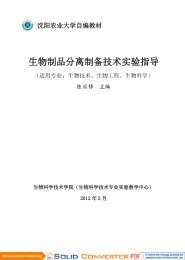
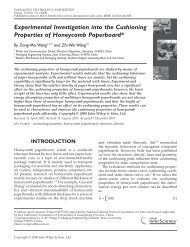
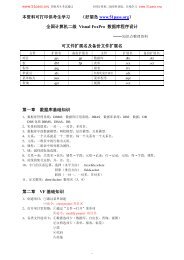
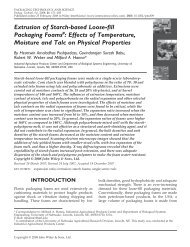
![()] 1](https://img.yumpu.com/45117883/1/190x143/-1.jpg?quality=85)
